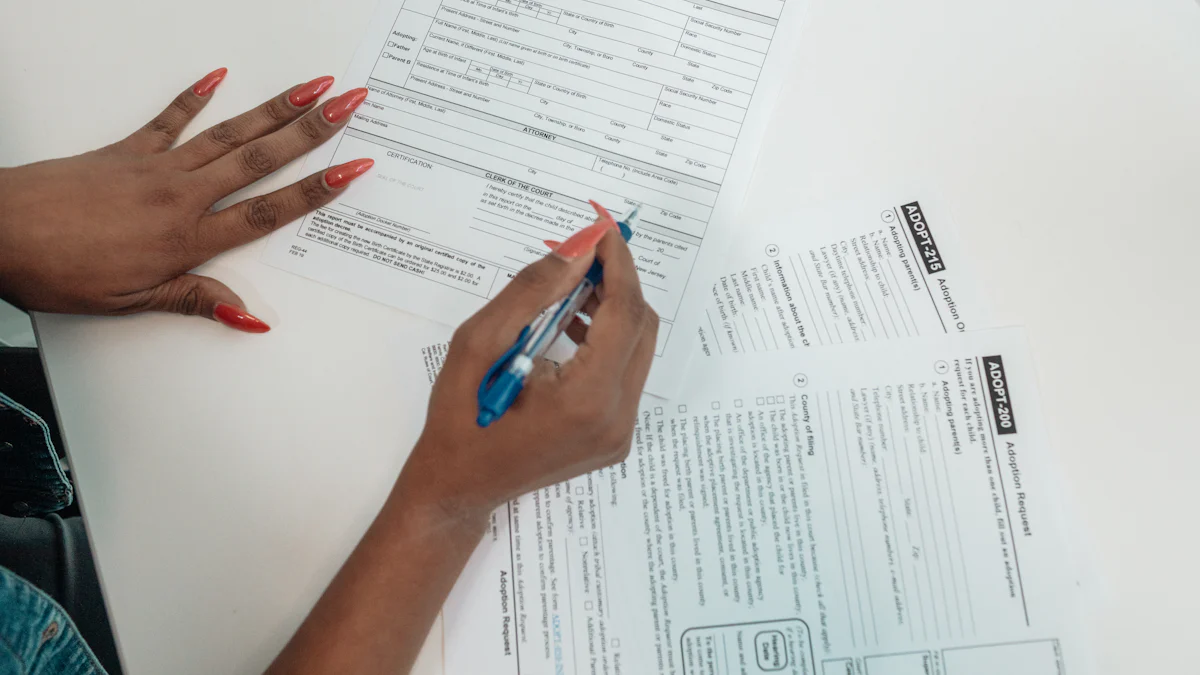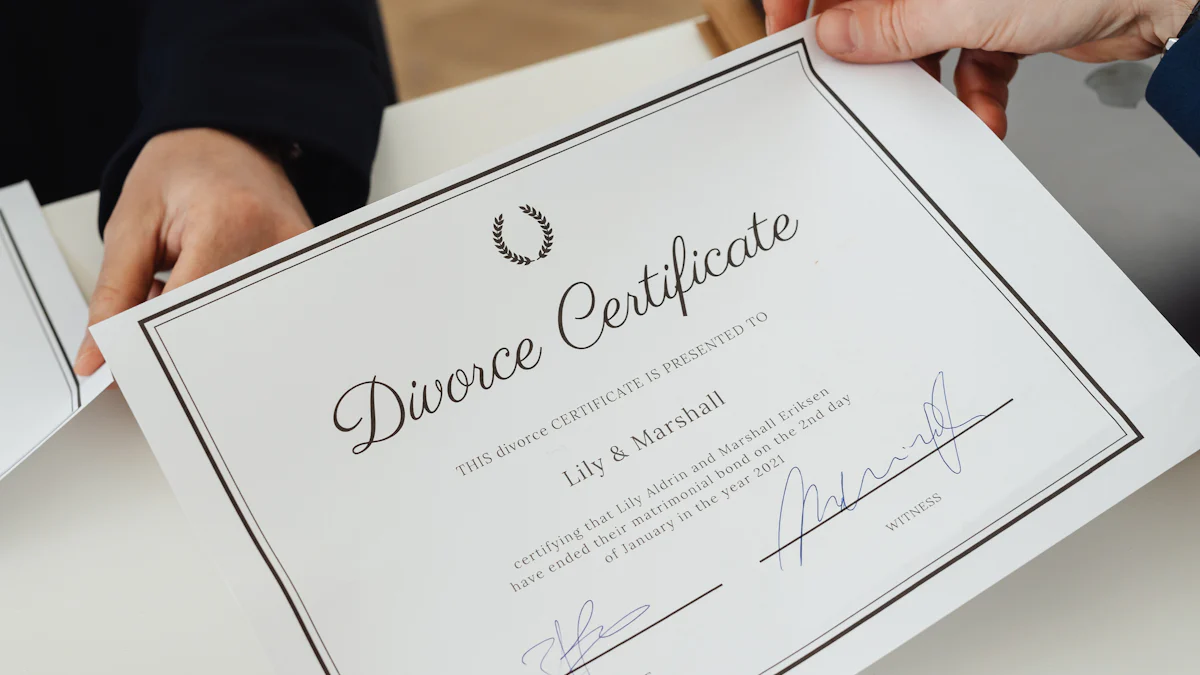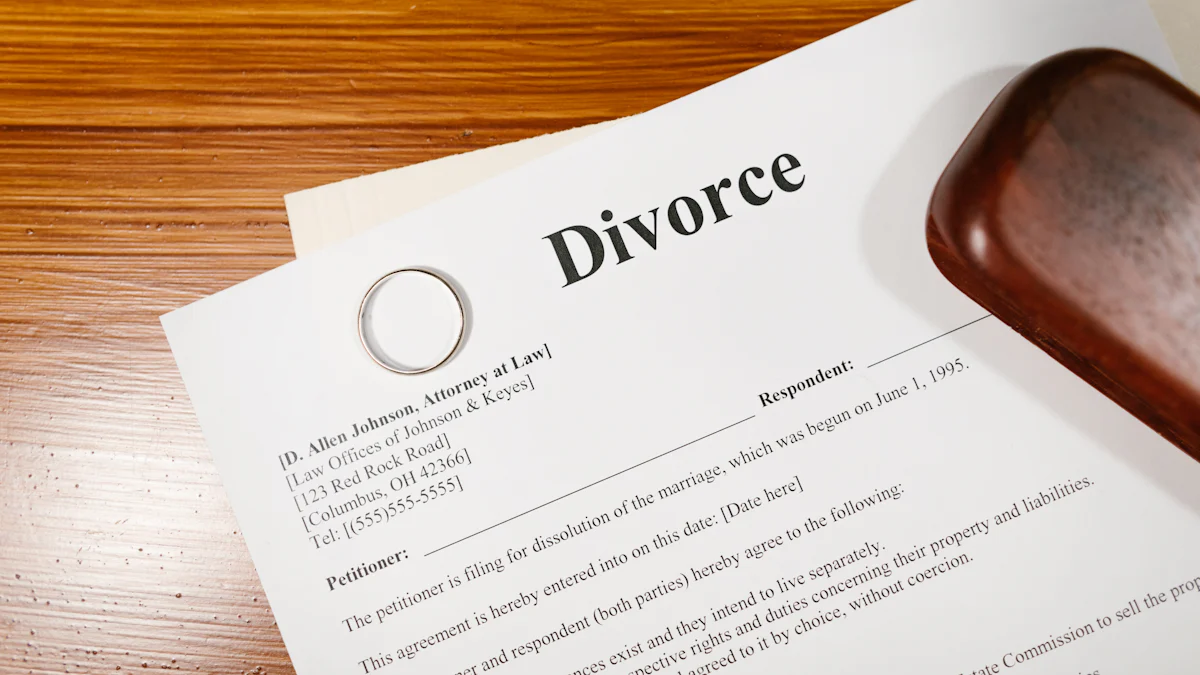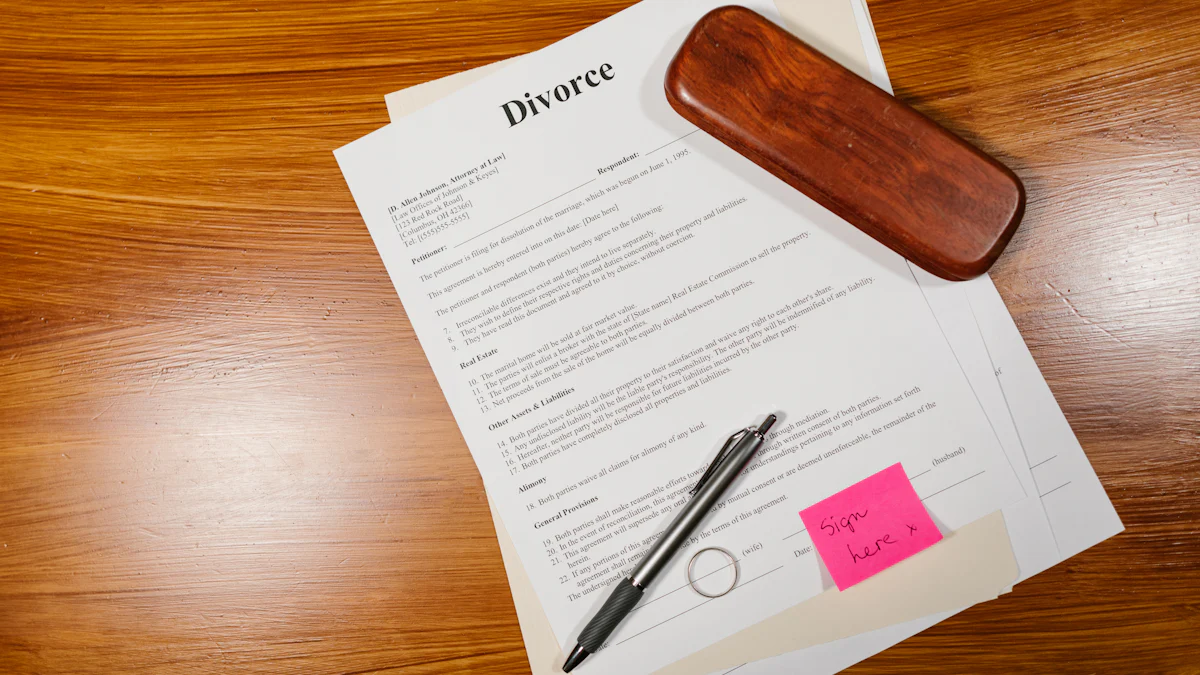How to Legally Change Your Name After Divorce

Changing your name after a divorce can feel like a fresh start. It symbolizes moving forward and embracing a new chapter in your life. You might want to reclaim your maiden name or choose something entirely different. Whatever your reason, understanding the legal process is crucial.
The steps involved to change your name after divorce can vary by state, but they generally include filing a petition and attending a court hearing. This guide will help you navigate the process smoothly, ensuring you know what to expect every step of the way.
Change Name After Divorce: Understanding the Legal Process

Changing your name after a divorce involves a few legal steps. Understanding these steps can make the process smoother and less stressful. Let's dive into how you can include a name change in your divorce proceedings and what it takes to file a petition for a name change.
Including a Name Change in Divorce Proceedings
You can simplify the name change process by including it in your divorce proceedings. When you file for divorce, you have the option to request a name change in your initial pleadings. This means you can ask the court to restore your maiden name or any other name you choose as part of the divorce decree.
If you didn't make this request initially, you could still bring it up at the final hearing. Including the name change in your divorce proceedings saves you from having to file a separate petition later.
Filing a Petition for Name Change
If you didn't include a name change in your divorce proceedings, don't worry. You can still change your name by filing a separate petition. Here's how:
Where to File
You need to file your petition for a name change at your local county court. Each state has its own rules, so it's essential to check the specific requirements for your area. The court clerk can provide you with the necessary forms and guide you through the process. Make sure you have all the required documents, such as your divorce decree, ready for submission.
Costs Involved
Changing your name isn't free. You'll need to pay a filing fee when you submit your petition. The cost varies by state and county, but it typically ranges from $100 to $200. Some courts may offer fee waivers if you can demonstrate financial hardship. It's a good idea to inquire about any additional costs, such as fees for certified copies of your name change order, which you might need for updating other documents.
By understanding these steps, you can navigate the process of changing your name after divorce with confidence. Whether you include it in your divorce proceedings or file a separate petition, knowing what to expect helps you move forward with ease.
Gathering Required Documents for Name Change

Before you can officially change your name after divorce, you'll need to gather some essential documents. Having these ready will make the process smoother and help you avoid unnecessary delays. Let's take a look at what you'll need.
Identification Documents
First, you'll need to provide identification documents. These typically include a government-issued ID, such as a driver's license or passport. Make sure these documents are up-to-date and reflect your current information. If your ID is expired, renew it before starting the name change process. Having valid identification helps verify your identity and supports your name change request.
Divorce Decree
Your divorce decree is a crucial document in the name change process. This legal document serves as proof of your divorce and may include your request to revert to your maiden name. If you didn't request a name change during the divorce proceedings, you might need a certified copy of the decree. You can obtain this from the court where your divorce was finalized. A certified copy often comes with a fee, so be prepared for that expense. This document will be necessary when updating your name with various agencies and institutions.
Name Change Petition
If you didn't include a name change in your divorce decree, you'll need to file a separate name change petition. This petition is a formal request to the court to change your name. You'll need to fill out the required forms, which you can usually get from your local county court. Make sure to complete the forms accurately and attach any necessary documents, like your divorce decree. Submitting a complete petition helps ensure a smooth process and reduces the likelihood of delays.
By gathering these documents, you set yourself up for a successful name change after divorce. Having everything in order makes the process less stressful and allows you to focus on starting this new chapter in your life.
Attending Court Hearings for Name Change

Attending a court hearing for your name change might seem daunting, but with the right preparation, you can approach it with confidence. This step is crucial in the process of changing your name after divorce, as the judge needs to review your request and ensure everything is in order.
Preparing for the Hearing
Preparation is key to a successful court hearing. Start by gathering all necessary documents. Bring your identification, divorce decree, and any other paperwork related to your name change petition. Double-check that everything is complete and accurate. You don't want to face delays because of missing information.
Next, familiarize yourself with the court's procedures. Visit the court's website or contact the clerk's office to understand what to expect. Knowing the rules and protocols can help you feel more at ease. Dress appropriately for the occasion. Business casual attire is usually a safe choice. It shows respect for the court and the seriousness of the matter.
Finally, practice what you plan to say. You might need to explain why you want to change your name. Keep your explanation clear and concise. The judge wants to ensure you have a legitimate reason for the request. Practicing beforehand can help you articulate your thoughts more effectively.
What to Expect During the Hearing
When you arrive at the courthouse, check in with the clerk. They will direct you to the correct courtroom. Once inside, wait for your case to be called. The judge will review your documents and ask you a few questions. This is your opportunity to present your reasons for the name change.
The judge's role is to ensure your request is legitimate and in compliance with the law. They will consider the evidence and your explanation. If everything is in order, the judge will likely approve your request. This approval is a significant step in the process of changing your name after divorce.
Remember, the hearing is a formal procedure, but it's also a chance for you to take control of your new identity. Approach it with confidence, knowing you've prepared thoroughly. Once the judge grants your request, you'll receive a court order confirming your new name. This document is essential for updating your personal records and notifying other entities of your name change.
Updating Personal Records After Name Change

Once the court approves your name change, it's time to update your personal records. This step is crucial to ensure that all your identification documents reflect your new name. Let's walk through the process of updating your records with various agencies.
Social Security Administration
Updating your name with the Social Security Administration (SSA) is a top priority. Your Social Security card is a key piece of identification, and having it updated ensures that your earnings are correctly reported.
Required Forms
To change your name with the SSA, you'll need to fill out the Application for a Social Security Card (Form SS-5). You can download this form from the SSA website or pick it up at your local SSA office. Along with the form, you'll need to provide proof of your identity and legal name change. This includes your court order for the name change and a government-issued ID, like your driver's license or passport.
Submission Process
Once you've gathered the necessary documents, submit them to the SSA. You can do this by mail or in person at your local SSA office. If you choose to mail your application, make sure to send certified copies of your documents, as the SSA will not return originals. After processing your application, the SSA will issue a new Social Security card with your updated name. This process usually takes a few weeks, so plan accordingly.
Department of Motor Vehicles
Your driver's license is another critical document to update after a name change. The Department of Motor Vehicles (DMV) handles this process.
Updating Your Driver's License
Visit your local DMV office to update your driver's license. Bring your current license, the court order for your name change, and any other required identification. Some states may also require proof of residency, so check your state's DMV website for specific requirements. Once you've submitted the necessary documents, the DMV will issue a new driver's license with your updated name. This step is essential for ensuring that your identification matches your new legal name.
Passport and Other Identification
Don't forget to update your passport and any other forms of identification. For your passport, you'll need to fill out the appropriate form, which varies depending on how long ago your passport was issued. Submit this form along with your current passport, a certified copy of your name change order, and a new passport photo. The U.S. Department of State will then issue a new passport with your updated name.
In addition to your passport, update other identification documents, such as your voter registration and any professional licenses. Each agency has its own process, so check their websites for specific instructions.
By taking these steps, you ensure that all your personal records reflect your new name. This not only helps avoid confusion but also solidifies your fresh start after divorce. Remember, changing your name is a significant part of moving forward, and keeping your records up-to-date is a crucial aspect of this transition.
Notifying Other Entities of Name Change

Once you've legally changed your name, it's time to inform various entities. This ensures that all your accounts and records reflect your new identity. Let's explore who you need to notify.
Financial Institutions
Start with your bank and credit card companies. They need to update your accounts to reflect your new name. Visit your local branch or call customer service. Bring your updated ID and the court order for your name change. This helps verify your identity and ensures a smooth transition.
Don't forget about your investment accounts and retirement funds. Contact your financial advisor or the institution managing these accounts. They will guide you through their specific process for updating your name.
Updating your name with credit bureaus usually happens automatically when you inform the Social Security Administration and your credit accounts. However, it's a good idea to check your credit report to ensure everything is correct.
Employers and Insurance Companies
Your employer needs to know about your name change. This ensures your payroll and benefits information is accurate. Inform your HR department and provide them with any necessary documentation. This might include your updated Social Security card and driver's license.
Insurance companies also need to update your records. Contact your health, auto, and home insurance providers. Provide them with your new name and any required documents. This ensures your policies remain valid and up-to-date.
Utilities and Service Providers
Don't overlook your utilities and service providers. This includes your electricity, water, gas, and internet companies. Log into your online accounts or call customer service to update your information. Having your bills in your new name helps avoid confusion and ensures you receive important communications.
Also, notify any subscription services you use, like streaming platforms or magazines. Update your name in their systems to ensure seamless service.
By notifying these entities, you ensure that all aspects of your life reflect your new identity. This step is crucial for maintaining consistency and avoiding potential issues down the road. Embrace this opportunity to fully step into your new chapter with confidence.
Additional Considerations for Name Change
Changing your name after a divorce involves more than just updating your documents. You need to consider how this change might affect other aspects of your life, like your credit and record-keeping.
Impact on Credit
You might wonder if changing your name will affect your credit score. The good news is it won't. Your credit history relies on multiple identifiers, such as your Social Security number, to track your financial activities. When you update your name, this new information gets added to your credit reports. However, it doesn't create a new credit file or erase any previous account details.
Experian, a leader in credit reporting, states, "Changing your name will not impact your credit. Your credit reports use multiple pieces of identification information, including your Social Security number, to compile your credit history."
Even though your credit score remains unaffected, it's crucial to ensure that financial institutions and credit bureaus have your updated information. This helps maintain the accuracy of your records and prevents any potential issues.
Chase, a major financial institution, emphasizes, "It's important for financial institutions and credit bureaus to have the proper information on file and be aware of this major change."
Regularly checking your credit reports is a smart practice. It allows you to spot any errors that might occur during the transition and report them promptly.
Keeping Records of the Name Change
Keeping thorough records of your name change is essential. These documents serve as proof of your new identity and can help resolve any discrepancies that might arise. Here's what you should keep:
Court Order: This is the official document that confirms your name change. Keep a certified copy in a safe place.
Updated Identification: Make sure you have copies of your updated driver's license, Social Security card, and passport.
Communication Records: Document any correspondence with financial institutions, employers, and service providers regarding your name change.
By maintaining these records, you ensure a smooth transition into your new identity. They provide a reference point if you encounter any issues with your updated information. Embrace this new chapter with confidence, knowing you're well-prepared for any challenges that might come your way.
You've taken a significant step by deciding to change your name after divorce. Let's recap the process:
Understand the Legal Process: Decide whether to include the name change in your divorce proceedings or file a separate petition.
Gather Required Documents: Collect identification, your divorce decree, and any necessary petitions.
Attend Court Hearings: Prepare thoroughly and present your case confidently.
Update Personal Records: Notify the Social Security Administration, DMV, and other agencies.
Inform Other Entities: Update financial institutions, employers, and service providers.
Updating all relevant records is crucial. It ensures consistency across your documents and safeguards your identity. Though it may seem tedious, this effort prevents future headaches and sets you up for a fresh start. Embrace this new chapter with confidence!
FAQ
Can I change my name to something other than my maiden name after divorce?
Yes, you can choose a new name after your divorce. You don't have to revert to your maiden name. The key is ensuring that the new name isn't for fraudulent purposes or to dodge legal responsibilities. You'll need to follow the standard name change process. This might involve a court visit to get a court order. Afterward, update your ID documents and other records with your new name.
How can I change my name back to my maiden name after getting divorced?
Changing your name back to your maiden name after divorce is straightforward. You can do this at any time, even if you didn't do it immediately after the divorce. The process remains the same. You'll need to file a petition and possibly attend a court hearing. Once approved, update your identification and records to reflect your maiden name.
Do I need a lawyer to change my name after divorce?
You don't necessarily need a lawyer to change your name after divorce. The process is usually simple enough to handle on your own. However, if you're unsure about the steps or face complications, consulting a lawyer might be helpful. They can guide you through the legal requirements and ensure everything is in order.
How long does the name change process take after divorce?
The time it takes to change your name after divorce varies. It depends on your state's laws and the court's schedule. Generally, it can take a few weeks to a couple of months. Filing your petition promptly and ensuring all documents are in order can help speed up the process.
Will changing my name affect my credit score?
Changing your name won't impact your credit score. Credit bureaus track your financial history using multiple identifiers, like your Social Security number. When you update your name, it gets added to your credit reports without altering your credit file. It's wise to check your credit report to ensure all information is accurate.
What documents do I need to update after changing my name?
After changing your name, update several key documents. Start with your Social Security card and driver's license. Then, update your passport, bank accounts, and credit cards. Don't forget to notify your employer, insurance companies, and utility providers. Keeping your records consistent helps avoid confusion.
Can I change my children's last name after my divorce?
Changing your children's last name after divorce requires additional steps. Both parents usually need to agree on the change. If one parent disagrees, you might need to go to court. The judge will consider the best interests of the child before making a decision.
Is there a deadline for changing my name after divorce?
There's no strict deadline for changing your name after divorce. You can do it whenever you're ready. However, handling it sooner can simplify the process. It ensures all your records and documents reflect your new identity without delay.
What if I want to keep my married name after divorce?
You can choose to keep your married name after divorce. Many people do this for personal or professional reasons. If you decide to keep it, there's no need to go through the name change process. Just continue using your current name as usual.
Do I need to notify my employer about my name change?
Yes, inform your employer about your name change. This ensures your payroll and benefits information stays accurate. Provide them with updated identification and any necessary documentation. Keeping your employer informed helps maintain consistency in your work records.
See Also
Successfully Managing Divorce Without Legal Representation
Understanding Divorce's Effect on Texas Estate Planning
Addressing Divorce's Influence on Your Texas Estate Plan
Post-Divorce Perspectives on Prenuptial Agreements and Estate Planning
Subscribe to get the updates!
Sign up now to receive timely blog updates.
I accept the email subscription terms.

